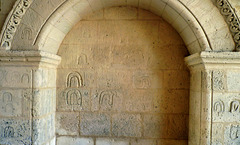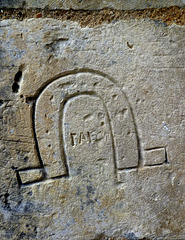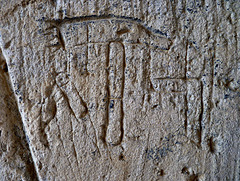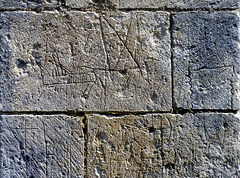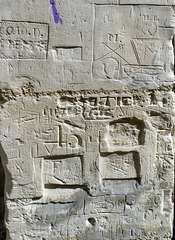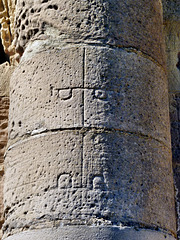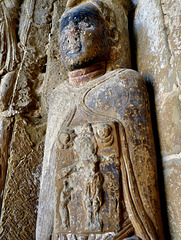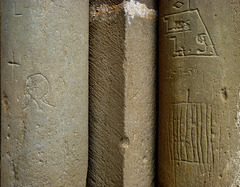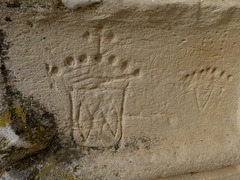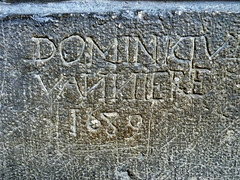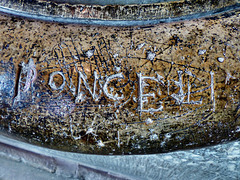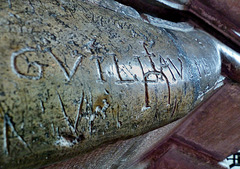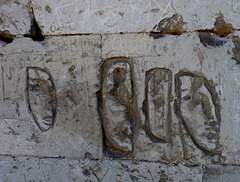
Carved graffiti
Pons - Hôpital des pèlerins
| |
|
Geoffroy III de Pons, Richard Lionheart´s vasall, fortified the town of Pons, placed on a limestone plateau over the valley, during the 12th century.
In 1160 Geoffroy founded the "hôpital des pèlerins", outside the walls of the town, as an older one was too small to host the growing numbers of pilgrims following the "Via Turonensis" on their way to Santiago de Compostella.
The Knight Templars led the Hopital in the beginning. After 1312 the Bishop of Saintes took over the responsiblity. After the Hundred Years' War and the Wars of Religion the pilgrimage had come to an end. So since the 16th century the Order of St. John of Jerusalem (Knights of Malta) used the buildings as a local hospital, that was closed during the French Revolution.
Many places aside the old pilgrimage routes have medieval graffiti. The sandstone walls around the portal of the old hôpital des pèlerins are covered with carved graffiti. A horseshoe like this one, combined with a cross, is a common pilgrim´s graffiti (see previous upload). It is believed, that the pilgrims so ensured a special blessing for their horses, mules and donkeys.
Pons - Hôpital des pèlerins
| |
|
Geoffroy III de Pons, Richard Lionheart´s vasall, fortified the town of Pons, placed on a limestone plateau over the valley, during the 12th century.
In 1160 Geoffroy founded the "hôpital des pèlerins", outside the walls of the town, as an older one was too small to host the growing numbers of pilgrims following the "Via Turonensis" on their way to Santiago de Compostella.
The Knight Templars led the Hopital in the beginning. After 1312 the Bishop of Saintes took over the responsiblity. After the Hundred Years' War and the Wars of Religion the pilgrimage had come to an end. So since the 16th century the Order of St. John of Jerusalem (Knights of Malta) used the buildings as a local hospital, that was closed during the French Revolution.
Many places aside the old pilgrimage route have medieval graffiti. The sandstone walls around the portal of the old hôpital des pèlerins are covered with carved graffiti. The horseshoes, seen here, are very common pilgrim´s graffiti. It is believed, that the pilgrims so ensured a special blessing for their horses, mules and donkeys.
Pons - Hôpital des pèlerins
| |
|
Geoffroy III de Pons, Richard Lionheart´s vasall, fortified the town of Pons, placed on a limestone plateau over the valley, during the 12th century.
In 1160 Geoffroy founded the "hôpital des pèlerins", outside the walls of the town, as an older one was too small to host the growing numbers of pilgrims following the "Via Turonensis" on their way to Santiago de Compostella.
The Knight Templars led the Hopital in the beginning. After 1312 the Bishop of Saintes took over the responsiblity. After the Hundred Years' War and the Wars of Religion the pilgrimage had come to an end. So since the 16th century the Order of St. John of Jerusalem (Knights of Malta) used the buildings as a local hospital, that was closed during the French Revolution.
Many places aside the old pilgrimage routes have medieval graffiti. The sandstone walls around the portal of the old hôpital des pèlerins are covered with carved graffiti. A horseshoe like this one is a common pilgrim´s graffiti (see previous uploads). Here there may be a name. Are there greek letters? GAI(SON) ?
Pons - Hôpital des pèlerins
| |
|
Geoffroy III de Pons, Richard Lionheart´s vasall, fortified the town of Pons, placed on a limestone plateau over the valley, during the 12th century.
In 1160 Geoffroy founded the "hôpital des pèlerins", outside the walls of the town, as an older one was too small to host the growing numbers of pilgrims following the "Via Turonensis" on their way to Santiago de Compostella.
The Knight Templars led the Hopital in the beginning. After 1312 the Bishop of Saintes took over the responsiblity. After the Hundred Years' War and the Wars of Religion the pilgrimage had come to an end. So since the 16th century the Order of St. John of Jerusalem (Knights of Malta) used the buildings as a local hospital, that was closed during the French Revolution.
Many places aside the old pilgrimage routes have medieval graffiti. The sandstone walls around the portal of the old hôpital des pèlerins are covered with carved graffiti.
Pons - Hôpital des pèlerins
| |
|
Geoffroy III de Pons, Richard Lionheart´s vasall, fortified the town of Pons, placed on a limestone plateau over the valley, during the 12th century.
In 1160 Geoffroy founded the "hôpital des pèlerins", outside the walls of the town, as an older one was too small to host the growing numbers of pilgrims following the "Via Turonensis" on their way to Santiago de Compostella.
The Knight Templars led the Hopital in the beginning. After 1312 the Bishop of Saintes took over the responsiblity. After the Hundred Years' War and the Wars of Religion the pilgrimage had come to an end. So since the 16th century the Order of St. John of Jerusalem (Knights of Malta) used the buildings as a local hospital, that was closed during the French Revolution.
Many places aside the old pilgrimage routes have medieval graffiti. The sandstone walls around the portal of the old hôpital des pèlerins are covered with carved graffiti. First time I found the Keys of Heaven. These crossed keys often stand for the Holy See. Here maybe somebody named Pierre, Petrus or Peter left them, as Saint Peter holds the keys as the gatekeeper.
Pons - Hôpital des pèlerins
| |
|
Geoffroy III de Pons, Richard Lionheart´s vasall, fortified the town of Pons, placed on a limestone plateau over the valley, during the 12th century.
In 1160 Geoffroy founded the "hôpital des pèlerins", outside the walls of the town, as an older one was too small to host the growing numbers of pilgrims following the "Via Turonensis" on their way to Santiago de Compostella.
The Knight Templars led the Hopital in the beginning. After 1312 the Bishop of Saintes took over the responsiblity. After the Hundred Years' War and the Wars of Religion the pilgrimage had come to an end. So since the 16th century the Order of St. John of Jerusalem (Knights of Malta) used the buildings as a local hospital, that was closed during the French Revolution.
Many places aside the old pilgrimage routes have medieval graffiti. The sandstone walls around the portal of the old hôpital des pèlerins are covered with carved graffiti. There is a hammer. It seems to be a slate hammer, roofers still use today.
Rioux - Notre-Dame de l’Assomption
| |
|
Not much is known about the history of Notre-Dame de l’Assomption, an outstanding example of the specific "style saintongeais".
The structure is so masterly built and has such sophisticated carvings, that it is believed, it may have served as a priory church, after it was completed end of the 12th / early 13th century.
As the walls are built from the soft local sandstone, it was easy to scratch graffiti into them. But, just as the carvings, the carved graffiti have weathered. It is impossible to date them, but they may have been carved in by pilgrims on the Via Tolosana. Here are crosses, sails - and a horse?
Surgères - Notre-Dame
| |
|
Notre-Dame de Surgères was erected in the center of a large castle in the 12th century. The fortification, founded in the 9th century as a motte, when the area was raided by the Vikings, then guarded the border of the historical province of Aunis once.
When the church was built a small town had developed around the defence already. Later a small priory and a "hopital" existed, as this was a halt on the Via Turonensis. The pilgrims had a lot to gape here, the facade is stunning 23 meters wide.
Eleanor of Aquitaine married Henry II of England in 1152, so the area changed hands and was ruled by the House of Plantagenet. During the Hundred Years' War Surgères experienced a long period of decline. Louis XI´s troops conquered the town in 1472 and the fortifications got destructed. During that time Notre Dame lost the tower and large parts of the nave, but not the facade!
Six blind arches once flanked the door, five arches above them on "the second floor". There are more than 100 capitals and corbels all over the facade. This seems to be a medieval encyclopedia.
Over the centuries, many visitors left graffiti on the facade, early pilgrims and late vandals. Seen here are two sailing ships, so there may have been seamen too. And couples in love..
Saint Mary of Eunate
| |
|
|
Saint Mary of Eunate stands isolated, as it was not erected in or near a village, but in the middle of fields. It is surrounded by arches, that gave this place the name, as (according to the tourist office) "Eunate" means "one hundred doors" in Basque.
Though, there is not much information about the origins of this wonderful, octogonal church, it has probably been an important place for the pilgrims since the 12th century, as from here to Puente la Reina, where the "Camino Aragonés" / "Via Tolosana" joins the busy "Camino Francés" is only a short walk.
The floorplan of Saint Mary of Eunate is surely inspired by the "Church of the Holy Sepulchre of Jerusalem". Such churches (eg Tomar, Estrella, Pisa..) are often connected to the Knights Templar, but there no proof, that they have ever been in this area. The earliest documented reference is from 1487 and just mentions the "Virgin of Eunate", but at that time, the church was already centuries old.
These are marks on the pillars outside. These may be a mason's mark or graffiti. I tend to see them as graffiti, depicting handcuffs. They were a symbol for "prisoned". One of the important halts on the "Via Lemovicensis" is Saint-Léonard-de-Noblat, where the relics of Saint Leonard are venerated. He was the patron saint for prisoners and one of his symbols are this kind of handcuffs.
Sos del Rey Católico - Iglesia de San Esteban
| |
|
Sos del Rey Católico is a quaint, historic town with a population of just over 600. Founded as "Sos" by Sancho I of Pamplona during the Reconquista in the early 10th century, the town changed its name to Sos del Rey Católico, after Ferdinand II of Aragon (aka "el Católico") was born here in 1452. The town is built on a mountaintop. You enter it by foot through the medieval gates, as the old walls, that surround the town still exist.
The building of the "Iglesia de San Esteban" (= Saint Steven) started already mid of the 11th century, financed by Estefania de Foix, young widow of Garcia Sanchez III of Pamplona. The church got enlarged and altered over the next centuries many times. A narthex with gothic vaults was added within the 16th century to protect this Romanesque portal from the 12th century against the weather. Just like in nearby Sangüesa (13kms northwest) statues flank the doors. There are three large ones on either side, and various small ones inbetween.
See the previous uploads for an overview. This is the a close up of the right sculpture. A person holds a book, depicting the crucification (with sun and moon). There are lots of graffiti here and at first I saw the letters as such, but they are not. It is an inscription. I think it reads (?)EST (E)va(n)geli(um), so the person holding it may be a priest - or even an evangelist. I am sure, that on the right side of the cross is a carved in graffito, depicting a standing pilgrim, resting on his staff.
Agüero - Iglesia de Santiago
| |
|
The Iglesia de Santiago stands surrounded by macchia at the end of a dust road about a kilometer southeast of Agüero. This isolated place is probably why it is named as well "Ermita de Santiago".
It is a very strange structure and I did not have much information about. At one time within the 12th century somebody had started to build a pretty large basilica (- in the middle of nowhere). Obviously money was not an issue, as gifted sculptors and experienced builders left their marks here. Then - some decades later, the building process stopped, the church was never completed.
No wonder, that the artist/workshop known as "Master of San Juan de la Peña" is even better known under the name of "Master of Agüero". I had seen his works in San Juan de la Peña and Sangüesa, but what he created here are real masterpieces.
The outside walls of the church are covered with lots of different mason marks.
The structure was obviously erected with a lot of effort in a short time - and so a task - for many masons. The + and the L on the left may be such marks, but what is seen to the right are carved graffiti. Maybe somebody named Lawrence carved in that gridiron, to honour his patron saint. As the church is so isolated people carving in graffiti here are undisturbed and have plenty of time.
Bourges Cathedral
| |
|
The "Cathédrale Saint-Étienne de Bourges" was erected as a replacement for a 11th-century structure. The construction started probably in the last quarter of the 12th century, around the same time, when the builders and bricklayers started in Chartres. The choir of the cathedral was in use by 1214, the nave was finished 1255. The cathedral was consecrated in 1324.
The western facade was finished by 1270. It is very wide (42m), as the four side aisles and central nave each have their own portal.
There are even two more (side-) portals, older ones, that were once part of the Romanesque cathedral that got demolished and was replaced end of the 12th century, by the structure seen today.
The walls near the portals are covered with carved graffiti, what is very common in France. This one is pretty elaborate, as a stone driller was used, to create the coat of arms. The vandal, who used the driller, may have been a member of the Huguenot troops, that tried to burn down the cathedral in 1565. They failed. Of course the graffitto could as well have been carved in after the French Revolution, but coats of arms, being a symbol of nobility, where a bit out of fashion then.
Reims - Cathedral
| |
|
|
"Notre-Dame de Reims" replaced an older church, burnt down in 1211. That church had been built on the site of the basilica where Clovis was baptized by Saint Remi, bishop of Reims, in 496. The erection of the the large Gotihc cathedral, the place,where the kings of France were crowned, started before 1220. In 1233 a dispute between the cathedral´s chapter and the population regarding taxation and jurisdication ended in a revolt. After several clerics were killed during the uproar, the chapter fled the town and work on the new cathedral was suspended for three years. By 1241 the choir was already used, the nave got roofed in 1299.
Work on the western facade was slow. It was completed within the 14th century, a hundred years after the work started.
During the Hundred Years' War the English held Reims after a long siege, but it got reconquered by Jeanne d'Arc´s army in 1429, so that Charles VII of France (aka "le Bien-Servi") was crowned here on 17 July 1429.
In the first weeks of WWI German shellfire burned, damaged and destroyed important parts of the cathedral. Restoration work began in 1919 - and is been steadily going on since.
"Notre-Dame de Reims" has had bad times in history. Wars, uproars, revolutions took place and left marks. I have always been fascinated by old grafitti, that could only be done, when the church was open and "unattendend". There are many graffiti inside the cathedral. The large bases of the large pillars are covered with names and dates.
Reims - Cathedral
| |
|
|
"Notre-Dame de Reims" replaced an older church, burnt down in 1211. That church had been built on the site of the basilica where Clovis was baptized by Saint Remi, bishop of Reims, in 496. The erection of the the large Gotihc cathedral, the place,where the kings of France were crowned, started before 1220. In 1233 a dispute between the cathedral´s chapter and the population regarding taxation and jurisdication ended in a revolt. After several clerics were killed during the uproar, the chapter fled the town and work on the new cathedral was suspended for three years. By 1241 the choir was already used, the nave got roofed in 1299.
Work on the western facade was slow. It was completed within the 14th century, a hundred years after the work started.
During the Hundred Years' War the English held Reims after a long siege, but it got reconquered by Jeanne d'Arc´s army in 1429, so that Charles VII of France (aka "le Bien-Servi") was crowned here on 17 July 1429.
In the first weeks of WWI German shellfire burned, damaged and destroyed important parts of the cathedral. Restoration work began in 1919 - and is been steadily going on since.
"Notre-Dame de Reims" has had bad times in history. Wars, uproars, revolutions took place and left marks. I have always been fascinated by old grafitti, that could only be done, when the church was open and "unattendend". There are many graffiti inside the cathedral. The large bases of the large pillars are covered with names and dates.
Reims - Cathedral
| |
|
|
"Notre-Dame de Reims" replaced an older church, burnt down in 1211. That church had been built on the site of the basilica where Clovis was baptized by Saint Remi, bishop of Reims, in 496. The erection of the the large Gotihc cathedral, the place,where the kings of France were crowned, started before 1220. In 1233 a dispute between the cathedral´s chapter and the population regarding taxation and jurisdication ended in a revolt. After several clerics were killed during the uproar, the chapter fled the town and work on the new cathedral was suspended for three years. By 1241 the choir was already used, the nave got roofed in 1299.
Work on the western facade was slow. It was completed within the 14th century, a hundred years after the work started.
During the Hundred Years' War the English held Reims after a long siege, but it got reconquered by Jeanne d'Arc´s army in 1429, so that Charles VII of France (aka "le Bien-Servi") was crowned here on 17 July 1429.
In the first weeks of WWI German shellfire burned, damaged and destroyed important parts of the cathedral. Restoration work began in 1919 - and is been steadily going on since.
"Notre-Dame de Reims" has had bad times in history. Wars, uproars, revolutions took place and left marks. I have always been fascinated by old grafitti, that could only be done, when the church was open and "unattendend". There are many graffiti inside the cathedral. The large bases of the large pillars are covered with names and dates.
Reims - Abbey of Saint-Remi
| |
|
|
The abbey was founded already in the sixth century. Since 1099 the relics of Saint Remi are kept here. Remi was the bishop of Reims who baptised Clovis, King of the Franks, in 496.
The abbey developed well and got very important. Charlemagne received Pope Leo III here. It was one of the richest convents in what is France today during the 9th century. From 780 to 945 the archbishops of Reims served as its abbots. Over centuries the "Holy Ampulla", holding the held the anointing oil for the coronation of the kings of France, was kept here. During the French Revolution the glass vial was publicly destroyed.
The present basilica was the abbey church, that was consecrated by Pope Leo IX in 1049. It was built "over the tomb" of Sait Remi. The nave, seen here, is 122m long - and 26m wide. The original vaulting got destroyed during WWI. The rebuilding process of the basilica was finally completed in 1958.
Here is the tomb of Saint Remi, as well as the tombs of King Louis IV (aka "Transmarinus") and his son Lothair III of France.
Charlemagne´s younger brother Carloman is buried here. Carloman died only 20 years old in 771. The widow Gerperga fled with two kids into the Kingdom of the Lombards for protection. A few years later, they fell into the hands of Charlemagne´s soldiers. No news about them ever since..
The walls of the tombs are covered with old graffiti.
Soissons - Abbey of St. Jean des Vignes
| |
|
The Abbey of St. Jean des Vignes was founded by Hughes Le Blanc for a community of Augustinian Canons in 1076. The Romanesque structures of the early years got replaced by buildings erected in Gothic style from the 13th century on.
During the Hundred Year´s War, the abbey got heavily fortified. The town was looted and burned down by the troops of Charles VI of France (aka "Charles the Mad") in 1415. About a century later the town suffered severely, when it was under siege of the armees during the Wars of Religion.
Prussian troops conquered Soisson in 1814. The Franco-Prussian War (1870/71) creating a lot of damage, shell fire in WWI destroyed again most of the Soissons. The towers of the Abbey were not hit at that time.
After the French Revolution the nave of the church was used as a quarry. Most of the other buildings of the former convent got converted into barracks. An explosion inside the ammunition dump in 1815 destroyed most of the church but the Gothic facade and the refectory. Thousands of soldiers lived in the barracks for some decades - and they had the time to cover all the walls around with numerous graffiti.
Soissons - Abbey of St. Jean des Vignes
| |
|
The Abbey of St. Jean des Vignes was founded by Hughes Le Blanc for a community of Augustinian Canons in 1076. The Romanesque structures of the early years got replaced by buildings erected in Gothic style from the 13th century on.
During the Hundred Year´s War, the abbey got heavily fortified. The town was looted and burned down by the troops of Charles VI of France (aka "Charles the Mad") in 1415. About a century later the town suffered severely, when it was under siege of the armees during the Wars of Religion.
Prussian troops conquered Soisson in 1814. The Franco-Prussian War (1870/71) creating a lot of damage, shell fire in WWI destroyed again most of the Soissons. The towers of the Abbey were not hit at that time.
After the French Revolution the nave of the church was used as a quarry. Most of the other buildings of the former convent got converted into barracks. An explosion inside the ammunition dump in 1815 destroyed most of the church. Thousands of soldiers lived in the barracks for some decades - and they had the time to cover all the walls around with numerous graffiti.
Jump to top
RSS feed- Latest items - Subscribe to the latest items added to this album
- ipernity © 2007-2024
- Help & Contact
|
Club news
|
About ipernity
|
History |
ipernity Club & Prices |
Guide of good conduct
Donate | Group guidelines | Privacy policy | Terms of use | Statutes | In memoria -
Facebook
Twitter


